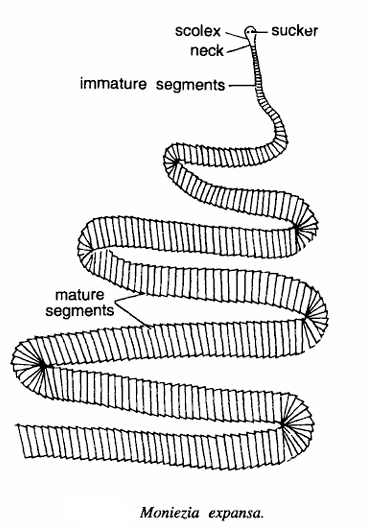Introduction
Moniezia expansa, commonly known as the sheep tapeworm or double-pored ruminant tapeworm, is a large cestode parasite inhabiting the small intestines of ruminants such as sheep, goats, and cattle. It is widespread in tropical and subtropical regions and is an important parasite for veterinary health due to its potential to cause monieziasis, especially in young animals. Occasionally, infection in pigs and rare cases in humans have been documented. Moniezia expansa is characterized by its very long body, unarmed scolex without hooks, and distinctive reproductive system featuring two sets of male and female organs in each proglottid. Understanding its biology, life cycle, habitat, and geographical distribution is essential for effective diagnosis and control.
Classification of Moniezia expansa
| Classification Level | Name | Characteristic |
|---|---|---|
| Kingdom | Animalia | Multicellular animals with specialized tissues |
| Phylum | Platyhelminthes | Flatworms with bilateral symmetry and unsegmented bodies |
| Class | Cestoda | Parasitic flatworms with segmented bodies (tapeworms) |
| Order | Cyclophyllidea | Tapeworms with distinct scolex bearing suckers |
| Family | Anoplocephalidae | Tapeworms typically infecting herbivores, often with unarmed scolex |
| Genus | Moniezia | Tapeworms with double sets of reproductive organs per proglottid |
| Species | Moniezia expansa | Sheep tapeworm with very broad, short proglottids and dual genital pores |

Habit and Habitat
Moniezia expansa adults inhabit the jejunum and ileum sections of ruminant intestines, where they attach loosely to the mucosa using four large suckers located on their scolex. Unlike many tapeworms, M. expansa lacks a rostellum and hooks, which is a defining characteristic.
The parasite is hermaphroditic and completes its life cycle using an intermediate host: oribatid mites present in the soil. Eggs released in ruminant feces contain oncospheres that must be ingested by oribatid mites. Inside the mite, the larval stage (cysticercoid) develops. Ruminants get infected by accidentally ingesting mites during grazing. This dual-environment lifecycle ties the parasite’s success to the presence of both grazing ruminants and soil-dwelling mites.
Geographical Distribution
Moniezia expansa is globally distributed, occurring in tropical, subtropical, and temperate regions wherever ruminant livestock are raised. It is prevalent in Africa, Asia, Europe, North and South America, and Australia. Its presence strongly depends on environmental conditions favoring the survival of oribatid mites and grazing habits of hosts. Seasonal fluctuations in prevalence correlate with mite population dynamics and climatic factors affecting soil conditions.
General Characteristics
- Body Structure: The adult tapeworm is extremely long, ranging from 6 to 10 meters in length, but very broad and flattened in width. The body consists of a scolex, neck, and strobila (chain of proglottids).
- Scolex: Features four large muscular suckers without any rostellar hooks or spines, facilitating attachment to the intestinal wall.
- Proglottids: Each proglottid segment is very broad yet short, containing two sets of reproductive organs (dual genital pores), a unique trait among tapeworms.
- Reproductive System: Hermaphroditic with numerous testes and ovaries in each segment enabling prolific egg production.
- Surface: The tegument is covered with tiny microvilli that increase absorption capacity since the tapeworm lacks a digestive tract.
- Eggs: Eggs are fairly large (~70 µm), typically found clustered in proglottids and released in host feces.

Special Features
- Double Sets of Reproductive Organs: Each proglottid has two complete reproductive systems positioned laterally, a distinctive adaptation in Moniezia expansa increasing reproductive output.
- Interproglottid Glands: The boundary region between segments contains a rosette-patterned cluster of glands whose function is not fully understood but may play a role in segment separation or host interaction.
- Intermediate Host Dependence: The requirement of an oribatid mite as intermediate host for larval development ties infection risk closely to soil and pasture conditions.
- Potential for Clinical Infection: Heavy infections, especially in young animals, can cause digestive disturbances like diarrhea and reduced weight gain.
- Size and Morphology: Notorious for their enormous length and broad, short body segments making them easy to identify macroscopically in infected animals.
Identification
Moniezia expansa is identified through a combination of morphological and microscopic observations:
- Adult Tapeworm: Visual identification in feces or during post-mortem inspection reveals long, broad, flattened segments.
- Scolex: Four suckers without rostellar hooks distinguish it from other cestodes.
- Eggs: Enlarged, tetrahedral-shaped eggs easily differentiated under microscopy.
- Proglottids: Broad, short segments each containing two lateral genital pores.
- Molecular Tools: PCR and DNA sequencing are increasingly used for precise species confirmation, especially to differentiate from similar species like Moniezia benedeni.
Lifecycle Summary
Adult Moniezia expansa release gravid proglottids containing eggs into the environment via host feces. These eggs are ingested by soil-dwelling oribatid mites, where the larval cysticercoid stage develops. Infected mites are accidentally consumed by grazing ruminants, allowing the cysticercoid to mature into adult worms in the small intestine, completing the life cycle.
Ecological and Economic Importance
Moniezia expansa infections impact sheep farming through decreased growth rates, poor feed conversion, and occasional diarrhea, especially in lambs. Large infestations can cause nutrient competition and intestinal damage. The parasite is widely distributed, causing economic losses in endemic areas. Control relies on pasture management, anthelmintic treatments, and monitoring intermediate host populations.
Conclusion
Moniezia expansa, the sheep tapeworm, is a large intestinal parasite with a fascinating lifecycle involving oribatid mites as intermediate hosts and ruminants as definitive hosts. Its unique morphology, especially the dual reproductive systems in broad proglottids, aids identification. While often non-lethal, it can cause significant health and economic issues in livestock management. Integrated parasitic control strategies are vital to minimizing its impact.
References
- https://en.wikipedia.org/wiki/Moniezia_expansa
- https://animaldiversity.org/accounts/Moniezia_expansa/
- https://www.sciencedirect.com/topics/agricultural-and-biological-sciences/moniezia-expansa
- https://pmc.ncbi.nlm.nih.gov/articles/PMC10478047/
- https://www.gbif.org/species/165410801
- https://basu.org.in/wp-content/uploads/2021/02/Moniezia.pdf
- https://www.fao.org/4/t0584e/T0584E04.htm
- https://pmc.ncbi.nlm.nih.gov/articles/PMC8291045/
- https://pubmed.ncbi.nlm.nih.gov/36074238/
- https://pmc.ncbi.nlm.nih.gov/articles/PMC11620685/
- https://malque.pub/ojs/index.php/msj/article/view/1565
- https://doaj.org/article/92e295d29abf466b85a5c8d009e55316
- https://malque.pub/ojs/index.php/msj/article/download/1565/1170/13750
- https://sciencescholar.us/journal/index.php/ijhs/article/view/9386
- https://wcvm.usask.ca/learnaboutparasites/parasites/moniezia-and-thysanosoma.php
- https://eajbse.journals.ekb.eg/article_98854_177055017bb58d1631b2424fd9a0375e.pdf
- https://pubmed.ncbi.nlm.nih.gov/39636935/
- https://www.sciencedirect.com/science/article/abs/pii/S1383576919303496
- https://www.sciencedirect.com/topics/immunology-and-microbiology/moniezia
- https://pmc.ncbi.nlm.nih.gov/articles/PMC6683355/
